Knotty Pine Kitchen Cabinets (Renovation & Updating Tips)
This guide to knotty pine kitchen cabinets shares what they are, their designs, if they’re a good choice, and how to clean, paint, and make your knotty cabinetry look modern.
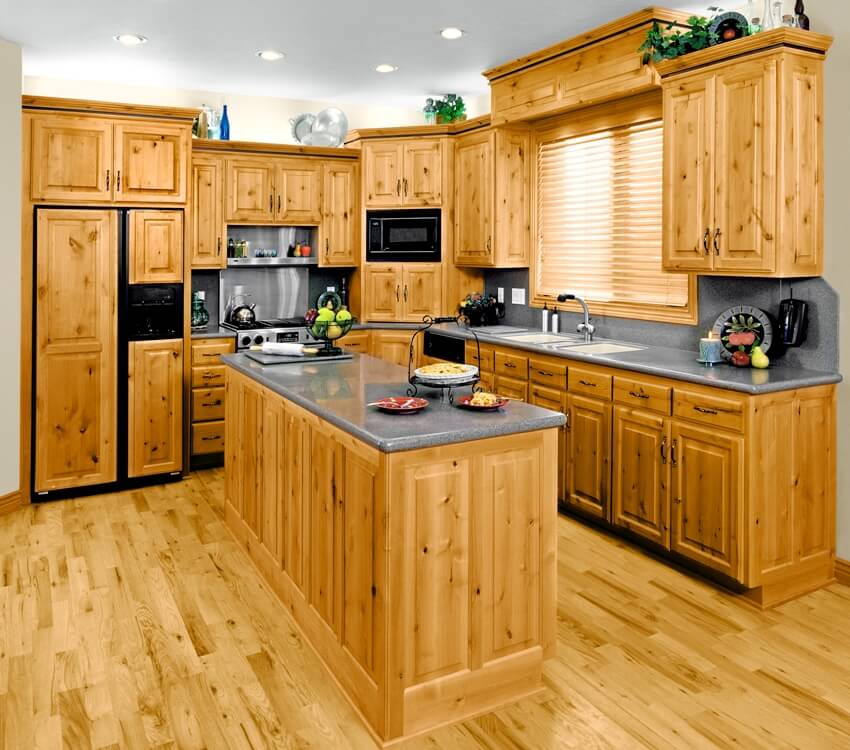
The heart of a house will always be in the kitchen and one of the popular choices that many homeowners consider knotty pine cabinets due to the warmth and beauty they offer in a very rustic way.
What Are Knotty Pine Cabinets?
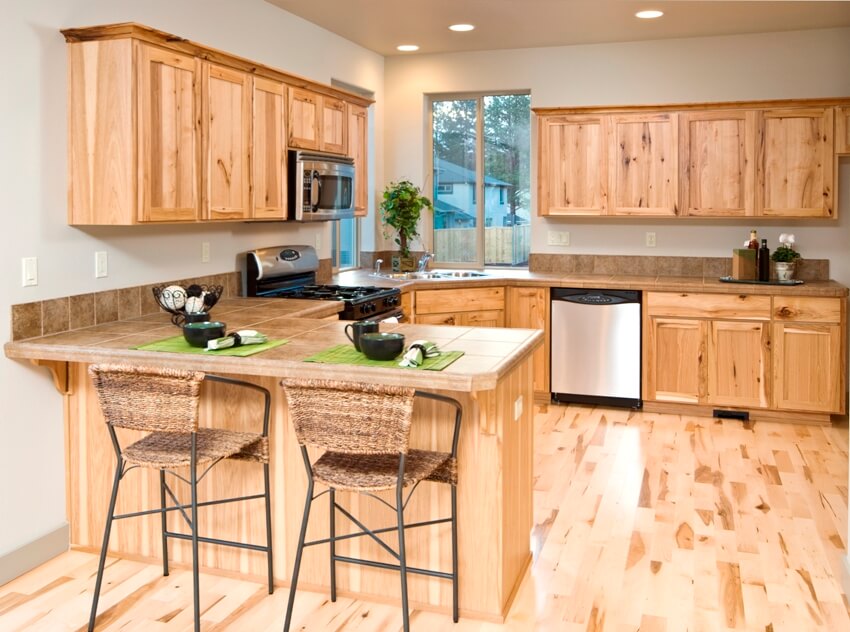
As part of the family of conifer trees, pine is one of the strongest softwoods that is inexpensive and exceptionally durable and can last for ten years or more. Knotty pine is like the clear variety with visible growth rings that form knots and has a unique pattern that gives kitchen cabinets a distinctive look throughout.
Knotty pine wood has a slightly yellow tint or lighter in color, which can create a sunny, bright, and airy feel in a kitchen. It can also be stained to a darker hue and still creates a welcoming feel.
When paired with distinctive hardware and decorative pieces, it complements the overall appeal for a more rustic, country or even retro look. Knotty timber is less expensive than clear pine wood. See our gallery of country kitchen cabinets here.
Extremely popular throughout the 1950s, the knotty pine refers to wood boards with many visible knots. It has a honey finish that varies in a range between orange and red colors.
Back then, this style with Formica countertops and wrought iron hardware were a popular decor highlight. Nowadays, designers and homeowners are returning the knotty look by introducing it again into modern home styles for a retro feel.
Is Pine A Good Choice For Kitchen Cabinets?

One of pine wood’s significant advantages is that it is very affordable and easy to sand and carve, making it great for kitchen cabinets. Homeowners tend to choose this cabinetry for their kitchen because of the natural, unique pattern on the cabinet, which adds character to the space.
Using this wood brightens the kitchen’s overall ambiance. The smell of the pine also evokes good feelings, making the room feel warm, cozy, and very welcoming.
Pinewood is easy to maintain, and its versatility is another advantage since it can easily be painted over, making it flexible to some changes within your kitchen cabinetry.
Unfinished Pine Cabinets
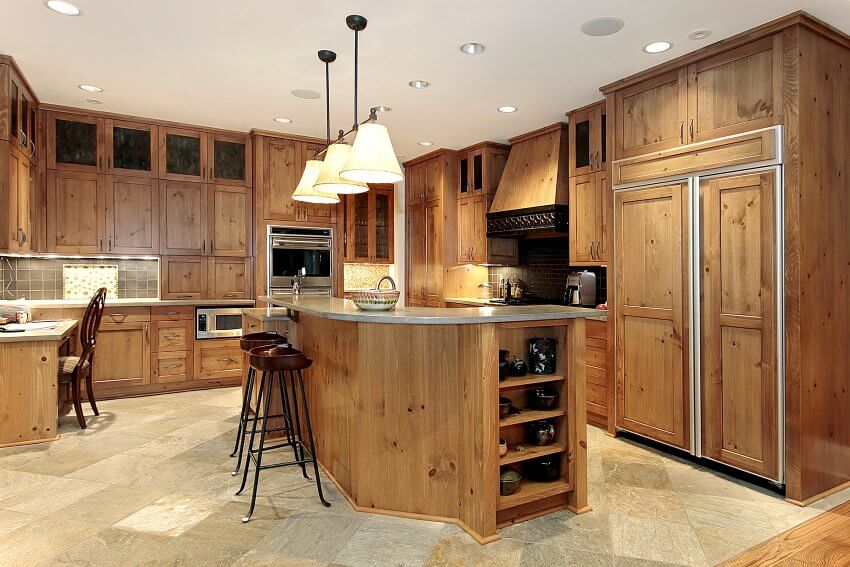
Having knotty pine kitchen cabinets offers warmth and a comfortable feel. Unfinished knotty pine cabinets are extremely appealing in their raw state because the patterns are so unique that they really bring out the beauty in a kitchen setting. You can never go wrong with unfinished pine cabinets.
A contemporary interior design style works best with unfinished cabinetry because of its smooth, plain surfaces and clean lines. Using unfinished knotty lumber is certainly less expensive.
Pine wood is flexible enough to stain or paint it any color with interesting paint techniques. The unfinished look of knotty cabinetry offers a natural look of wood, which adds character to your kitchen cabinetry.
How To Make Knotty Pine Cupboards Look Modern?

Since a soft wood like pine is easier to refinish and stain than other hardwood cabinets, knotty cabinetry can easily be modernized and spruced up by incorporating paint, stain, and decorative and architectural elements.
There are a variety of modern impressions through paint applications such as stenciling, murals, or abstract painted designs in addition to simply painting your knotty pine cabinets with a solid modern shade of paint. You can also try a paint splatter technique for an unusual and eclectic appearance.
Since pine wood is porous, it easily absorbs a wide range of stains. If your cabinetry has old paint or varnish, you need to strip and sand it before you can stain the wood in a color of your choice. To minimize absorption, you can buff the stain into the wood or use a rub-on or cream stain.
Another way to make your knotty woodwork look modern is to apply faux finishing techniques using gold gilding, creating a crackled paint surface, or distressing by painting and then selectively sanding away portions of paint at the edges. Sealing and protecting any faux finishes with polyurethane ensures long wear and durability.
Replacing existing cabinet hardware with modern design hardware such as chrome or glass pulls and knobs, or other unusual options is one way you can modernize the look of your cabinetry. Adding wood trim, decorative wood embellishments, and decals to your wooden surfaces creates a stylish and distinctive look.
Consider replacing the center panels of your cabinetry with stained, beveled, or frosted glass for an upscale, modern look. Check our gallery of modern kitchen cabinets for more ideas.
Painting Pine Wood Cabinets

Painting knotty pine cabinets can give your kitchen a more stylish look and feel. However, there are some things you need to consider before you paint your cabinetry. The knots can make it hard to paint this type of wood.
To paint knotty pine, there must be much priming and sanding to eliminate the knot’s appearance in the wood. Also, remember that an oily pine may not take paint well, while unfinished surfaces absorb many shades and can give the cabinets uneven coverage.
Before painting the wood, if it is unfinished, clean it thoroughly to remove grime and grease because painting over dirty cabinets won’t let the paint adhere properly.
But for stained knotty wood paneling, remove the old wood stain first by using a mild detergent mixed with water and a sponge to wipe the surface. This process also removes dirt and other contaminants. Wipe with a clean cloth to remove any soap residue before you start prep work and painting your cupboards.
The next step is to fill in all of the scratches and holes with latex-based wood filler and a plastic putty knife. Then lightly sand the cabinet surface, starting with 80-grit sandpaper, and sand the surface once again using the 120-grit to smooth out any bumps and give the surface a gritty finish.
Lastly, use a 200-grit sandpaper to give it a finer finish, which will help the paint adhere to the wood’s surface. Remove all the dust by wiping it down with a clean wet cloth.
Usually, painting needs at least one coat of primer before starting the painting process. Using primer helps seal the pores, ensuring even coverage and better hides the knots.
Apply a thin primer layer on the cabinets and let the coat dry overnight. A paint sprayer can also give you an even coat and guarantee a smoother finish than a paintbrush. Fill up the paint pot with the topcoat, spray a thin coat of paint and let the first coat dry for a day and then apply a second coat for best coverage.
How To Clean Pine Cabinetry
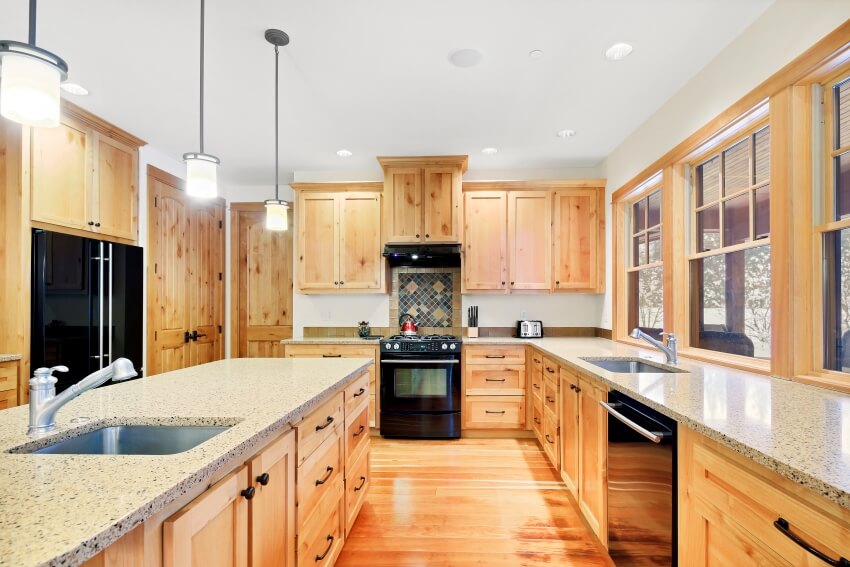
Knotty pine cabinets, like other wood cabinetry, are liable to wear and tear. Cleaning this cabinetry is not different from cleaning it like most other wood pieces. Start with any mild detergent mixed with water to scrub away dirt and grime.
Unfinished cupboards can be scoured with a little paint thinner to remove stubborn spots. Try mixing 50% water and 50% distilled vinegar for a streak-free look. However, ensure that you do not spray the distilled vinegar directly on the surface; instead, spray it onto a cloth and gently wipe your knotty pine cabinets.
These methods can help extend your kitchen cabinetry’s lifespan. Of course, specialty wood or cabinet cleaners are highly effective, and they are available at most general stores. However, they tend to be a little more expensive.
Slowly clean your cabinetry by washing and scrubbing one side at a time. When washing your surfaces, limit the moisture to protect them; do not soak the cabinets in water. Instead, dip the cloth in soapy water to dampen it, ensuring you squeeze the cloth to remove excess water.
When scrubbing the outside surfaces of your kitchen cupboards, start from top to bottom. Ensure you take time on the corners to clean more hidden dirt from hard-to-reach areas. Scrub these tough spots with a toothbrush dipped in soapy water.
Avoid letting water sit inside the cabinets. Rinse and dry each cabinet completely and leave the doors open until they totally are dry.
What Color Countertop Goes With Pine Cabinetry?

Since knotty pine wood is typically a light-yellow orange in color and the knots will be darker brown, a lighter neutral color will pair well as it will create a beautiful balanced monochromatic appearance.
Pairing a black granite countertop with knotty pine cabinetry makes a strong statement in an industrial style or mid-century modern style kitchens. While slightly off-white granite color combined with the natural soft characteristics of the cabinetry offers a rustic style kitchen.
How about trying to pair blue-green granite with your knotty pine kitchen cabinets? Since orange-yellow and blue-green are complementary colors, this pairing will highlight each color and bring out the rich intensity of each shade. Today, this color scheme will work perfectly for a mid-century style kitchen.
When it comes to backsplash materials there are an assortment of options that pair perfectly. Glass, patterned, mosaic, or subway tiles will all look stylish and bring a contemporary style to the design. In comparison, natural stones like travertine, slate, and tumbled marble can reinforce the rustic or farmhouse look. Brick or faux brick tiles are another rustic material that can pair well and provide warm tones to the layout.
The backsplash is an excellent area to introduce color. Get samples of products you like to pair up with your cupboards and see if they add the right touch.
Keeping these general cool, warm, and neutral shades in mind, you have a few options for pairing these with knotty pine cabinetry.
For more related articles, visit our guide to alder kitchen cabinets.

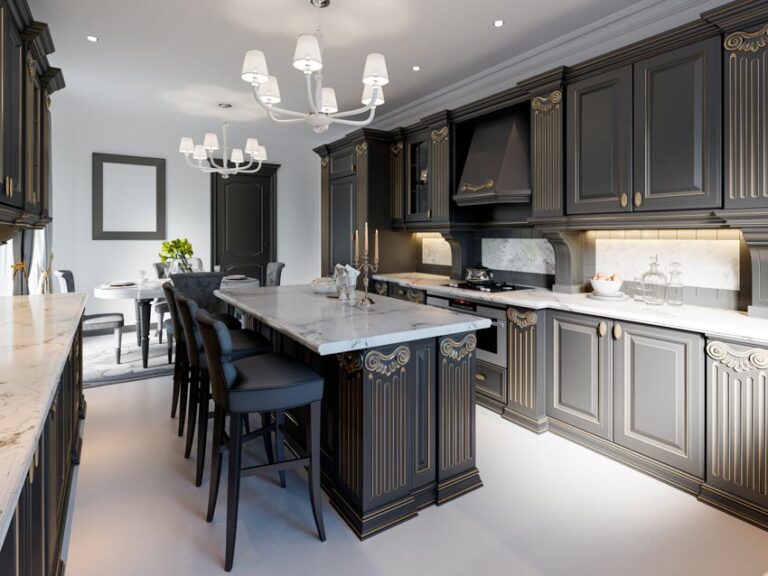
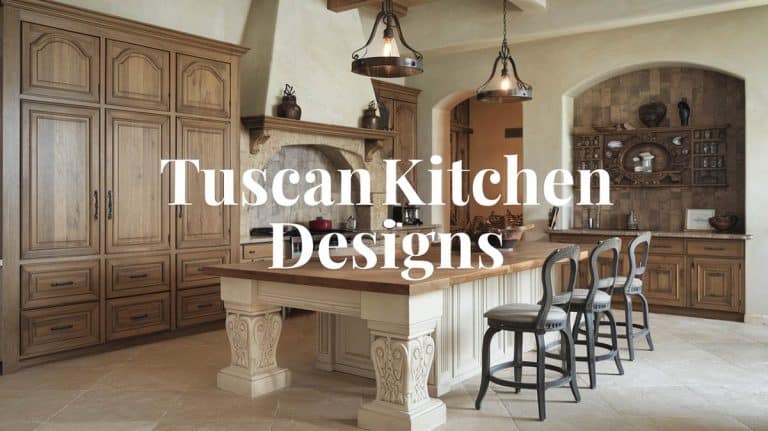

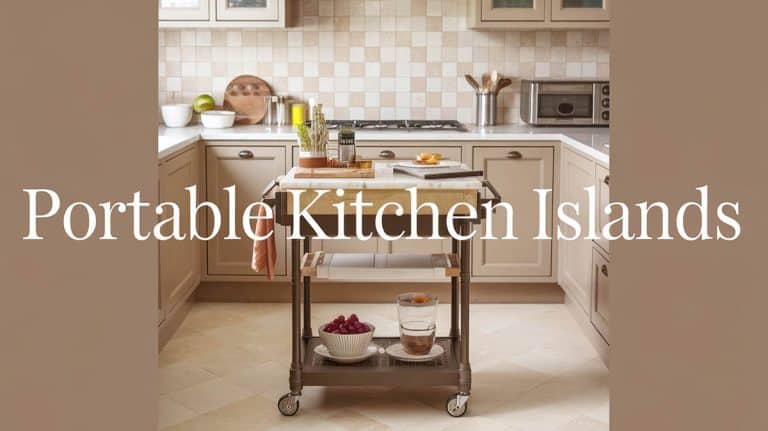
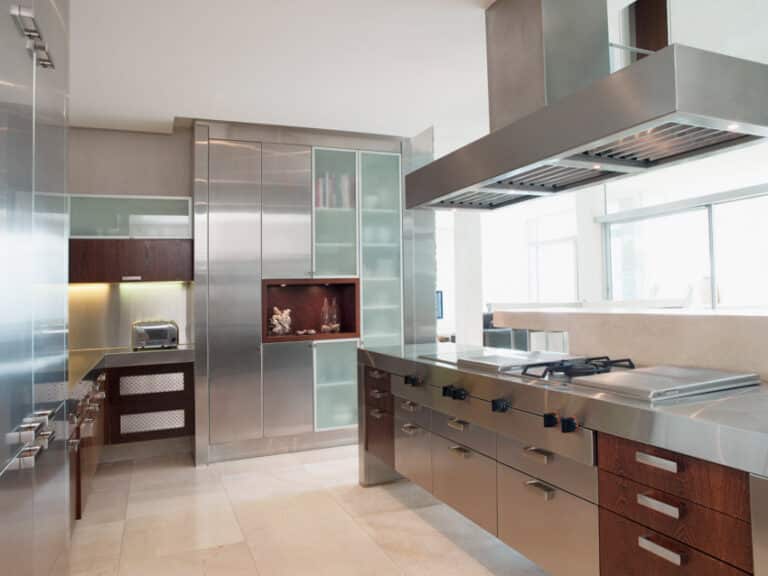
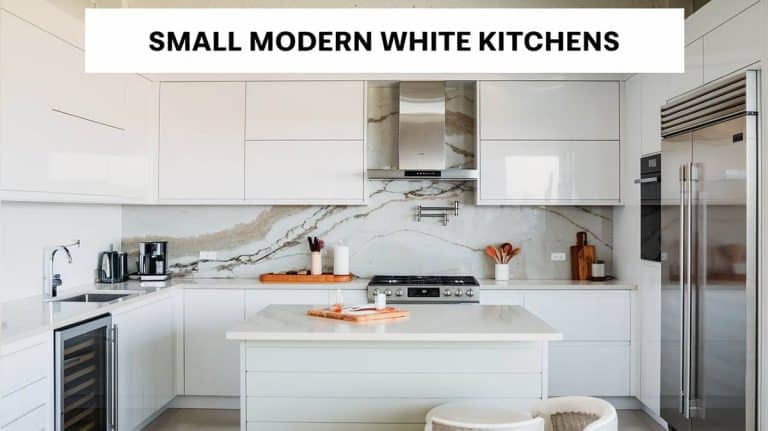
We need a Knotty Oak Wall Cabinet measuring 24″W x 48″Hx 12″D, can you help?